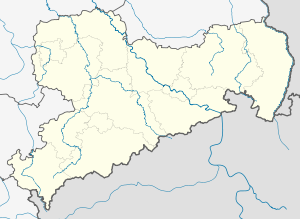Löbauer Viaduct
Coordinates: 51 ° 5 ′ 54 ″ N , 14 ° 40 ′ 41 ″ E
| Löbauer Viaduct | ||
|---|---|---|
| View of the viaduct arches restored after the war (2012) | ||
| use | Railway bridge | |
| Convicted | Görlitz – Dresden railway line | |
| Subjugated | Löbauer water | |
| place | Löbau | |
| Entertained by | DB network | |
| construction | Arch bridge made of stone | |
| overall length | 190 m | |
| Number of openings | 9 | |
| height | 28.6 m | |
| opening | July 1, 1847 | |
| location | ||
|
|
||
| Map of Löbau around 1844. | ||
| The Görlitz – Dresden railway line runs north of the old town. | ||
The Löbauer Viaduct is a railway bridge over the Löbauer Wasser in Löbau in Upper Lusatia . The 190 meter long viaduct crosses the double- track Görlitz – Dresden line with nine arches at a height of 28.6 meters .
The viaduct is located north of Löbau's old town at the entrance to the Löbau (Sachs) train station from the direction of Görlitz .
history
Construction work on the Görlitz – Dresden railway began in May 1844 near Dresden and reached Löbau in December 1846. Construction work east of Löbau also progressed, so that on April 29, 1847 the first test drive across the Saxon-Prussian border away to Reichenbach could take place. The test train also crossed the 190 meter long viaduct over the Löbauer Wasser , which leads the route at the eastern exit at a height of 28.6 meters and with nine arches across the valley. The scheduled train service was not officially started until July 1st. On September 1, 1847, the entire length of the railway line to Görlitz was opened, where it was possible to transfer or reload goods onto NME trains.
Before Christmas 1854, the miller of the Wetzschkemühle below the Löbauer Viaduct first noticed a crack on the second bridge pillar, which enlarged during the Christmas holidays. He reported the crack to the Löbauer production engineer, Bahr, who stuck a sheet of paper over the crack and knocked a wedge into the crack in order to observe the progress of the crack using these two tools. The crack spread so quickly that shortly afterwards it was decided to support the pillar with wood. In addition, a guard monitored the crack around the clock. On New Year's Eve, the residents of the Wetzschkemühle were awakened and evacuated because the viaduct was threatened with collapse. At 9:30 a.m. on New Year's Day, the second pillar collapsed and tore the third pillar with it into the depths, which in turn damaged the fourth pillar so badly that it had to be blown up. When the fourth pillar was blown up, the fifth one also buckled and the sixth pillar also had to be blown up, which tore the seventh with it when it was blown. Six of the once eight pillars were in the valley of the Löbauer water. The railway administration set up an interim station in Wendisch-Cunnersdorf east of Löbau and rail replacement services with horse-drawn carriages to the Löbau station.
The builder of the collapsed viaduct took his own life, although the guarantee period for the structure had already expired. The inauguration of the new viaduct under the direction of the Hötasch Government Building Council took place on August 28, 1856. The new viaduct was to last for almost 90 years. On the last day of the Second World War - May 7, 1945 - he fell victim to the Wehrmacht's demolition squads.
On the Görlitz – Dresden railway line, the makeshift Löbau Ost stop was set up at the eastern bridgehead of the destroyed viaduct . After the provisional repair of numerous bridges between Löbau and Görlitz, shuttle traffic between the two Upper Lusatian towns was resumed on August 6, 1945. The timetable provided for a two-kilometer walk. In November 1945, trains could again run over the provisionally repaired viaduct. After the Löbauer and Bautzen viaducts were provisionally passable again, the first passenger train ran from Görlitz to Dresden-Neustadt on November 10, 1945 .
The temporary bridge remained in place until 1984, as the construction capacities were previously insufficient. The four newly built arches differ significantly in their coloring. In 1985 the second track was relocated from the east exit from Löbau station over the viaduct and on to Zoblitz. After the war it fell victim to the reparation demands of the Soviet Union.
Several jackdaw nest boxes were attached to it by the Löbau Nature Conservation Association in the 1990s . During the Saxon State Horticultural Show 2012 in Löbau, the viaduct was located in the garden show grounds.
literature
- Wilfried Rettig : Railway in the three-country corner. East Saxony (D), Lower Silesia (PL), North Bohemia (CZ). Volume 1: History of the main routes, operating points, electrification and route descriptions. EK-Verlag, Freiburg (Breisgau) 2010, ISBN 978-3-88255-732-9 .
- Hans von Polenz: The railway in Löbau. Memories and pictures. Self-published by Ostsächsische Eisenbahnfreunde eV, Löbau 1996.
- Wilfried Rettig: Görlitz railway junction. Bufe-Fachbuch-Verlag, Egglham 1994, ISBN 3-922138-53-5 .





